2012 TOYOTA YARIS HYBRID air condition
[x] Cancel search: air conditionPage 531 of 704

531 4-3. Do-it-yourself maintenance
4
Maintenance and care
YARIS_F (including HV)_WE_52C79EUnder the instrument panel
FuseAmpereCircuit
1 TAIL NO.2 10 A
Front position lights, tail lights,
license plate lights
2 PANEL 5 AInstrument panel lights, manual
headlight leveling dial, gauge and
meters
3 DOOR R/R 20 A Power window
4 DOOR P 20 A Power window
5 ECU-IG NO.1 5 ARear window defogger, main body
ECU, brake system, vehicle stabil-
ity control system, shift lock control
system, audio system, windshield
wipers
6 ECU-IG NO.2 5 A Electric power steering system
7 A/C 7.5 A Air conditioning system
8 GAUGE 10 ABack-up lights, shift lock control
system, rear seat belt reminder
lights, auto anti-glare inside rear
view mirror, hybrid transmission,
audio system, multiport fuel injec-
tion system/sequential multiport
fuel injection system, rain sensor
9 WASHER 15 A Windshield wipers and washer
10 WIPER 20 A Windshield wipers and washer
11 WIPER RR 15 A Rear window wiper
Page 563 of 704
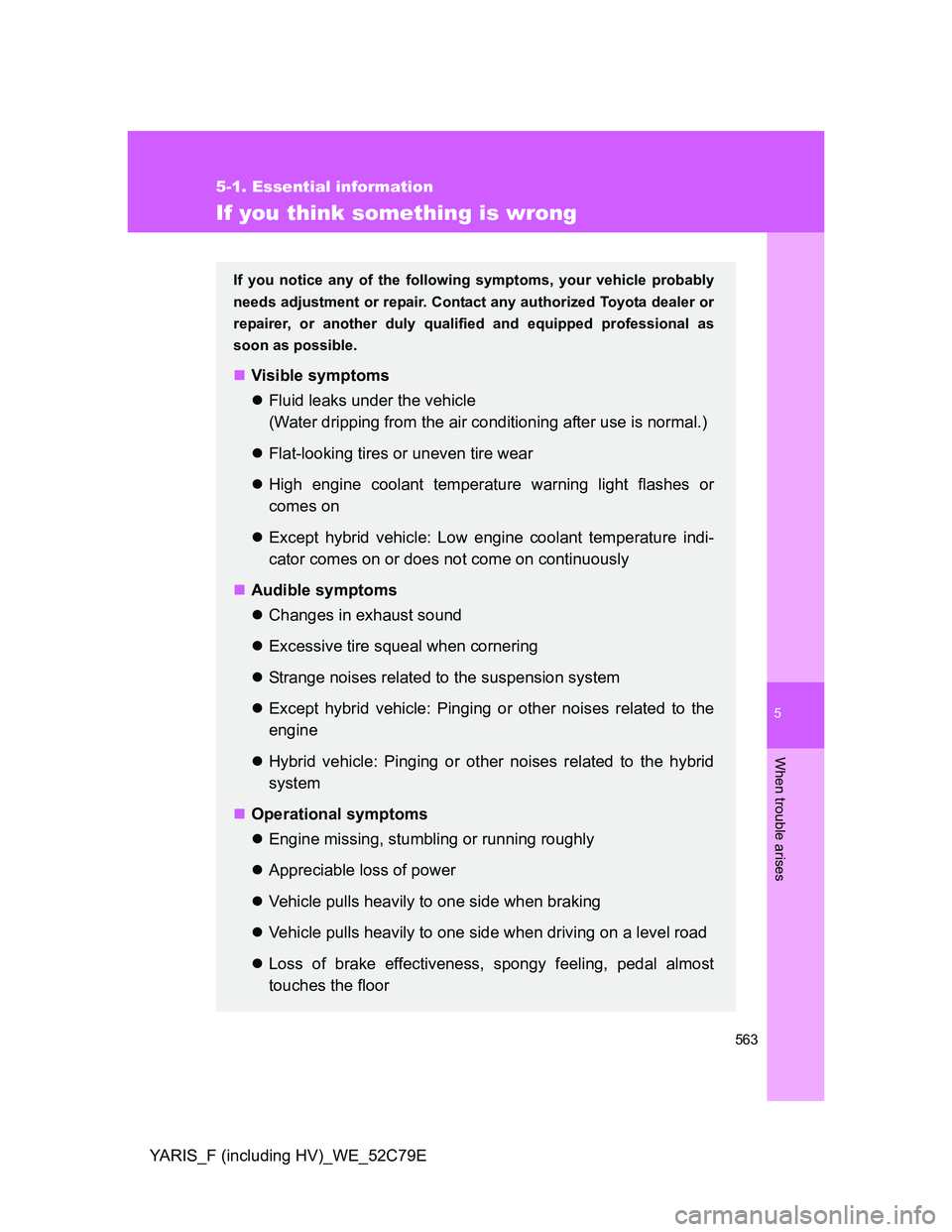
5
563
5-1. Essential information
When trouble arises
YARIS_F (including HV)_WE_52C79E
If you think something is wrong
If you notice any of the following symptoms, your vehicle probably
needs adjustment or repair. Contact any authorized Toyota dealer or
repairer, or another duly qualified and equipped professional as
soon as possible.
Visible symptoms
Fluid leaks under the vehicle
(Water dripping from the air conditioning after use is normal.)
Flat-looking tires or uneven tire wear
High engine coolant temperature warning light flashes or
comes on
Except hybrid vehicle: Low engine coolant temperature indi-
cator comes on or does not come on continuously
Audible symptoms
Changes in exhaust sound
Excessive tire squeal when cornering
Strange noises related to the suspension system
Except hybrid vehicle: Pinging or other noises related to the
engine
Hybrid vehicle: Pinging or other noises related to the hybrid
system
Operational symptoms
Engine missing, stumbling or running roughly
Appreciable loss of power
Vehicle pulls heavily to one side when braking
Vehicle pulls heavily to one side when driving on a level road
Loss of brake effectiveness, spongy feeling, pedal almost
touches the floor
Page 580 of 704

580 5-2. Steps to take in an emergency
YARIS_F (including HV)_WE_52C79E
Passenger detection sensor and passenger seat belt reminder
If luggage is placed on a passenger seat, the passenger detection sensor
may cause the warning light to flash even if a passenger is not sitting in
the seat.
If a cushion is placed on the seat, the sensor may not detect a passen-
ger, and the warning light may not operate properly.
Electric power steering warning light (warning buzzer)
Except hybrid vehicle: When the battery charge becomes insufficient or the
voltage temporarily drops, the electric power steering system warning light
may come on and the warning buzzer may sound.
Hybrid vehicle: When the 12-volt battery charge becomes insufficient or the
voltage temporarily drops, the electric power steering system warning light
may come on and the warning buzzer may sound.
If the malfunction indicator lamp comes on while driving
For some models, the malfunction indicator lamp will come on if the fuel tank
becomes completely empty. If the fuel tank is empty, refuel the vehicle
immediately. The malfunction indicator lamp will go off after several trips.
If the malfunction indicator lamp does not go off, contact any authorized
Toyota dealer or repairer, or another duly qualified and equipped profes-
sional as soon as possible.
If the engine oil change reminder light flashes (diesel engine with a
DPF system)
Repeated short trips and/or low-speed driving may cause the oil to degrade
sooner than usual, regardless of the actual distance driven. If this happens,
the engine oil change reminder light will flash.
Engine oil change reminder light comes on (diesel engine only)
Vehicles without a DPF system:
Replace the engine oil and oil filter when the engine oil change reminder
light does not come on even if you have driven over 40000 km (25000 miles)
after the engine oil was changed.
There is a possibility that the engine oil change reminder light has been illu-
minated when you have driven less than 40000 km (25000 miles) based on
a usage or driving condition.
Page 581 of 704

5
581 5-2. Steps to take in an emergency
When trouble arises
YARIS_F (including HV)_WE_52C79E
Vehicles with a DPF system:
Replace the engine oil and oil filter when the engine oil change reminder
light does not come on even if you have driven over 15000 km (9300 miles)
after the engine oil was changed.
There is a possibility that the engine oil change reminder light has been illu-
minated when you have driven less than 15000 km (9300 miles) based on a
usage or driving condition.
CAUTION
When the electric power steering system warning light comes on
The steering wheel may become extremely heavy.
If the steering wheel becomes heavier than usual when operating, hold
firmly and operate using more force than usual.
When driving to clean the DPF catalytic converter
When driving, pay sufficient attention to weather, road conditions, terrain and
traffic conditions, and be sure to observe traffic laws and/or regulations. Fail-
ure to do so may cause an unexpected accident, resulting in death or seri-
ous injury.
NOTICE
If the fuel filter warning light comes on (diesel engine only)
Never drive the vehicle with the warning light on. Continued driving with
water accumulated in the fuel filter will damage the fuel injection pump.
When the DPF system warning light comes on (diesel engine with a
DPF system)
If the DPF system warning light is left on without performing cleaning, after
an additional 100 to 300 km (62 to 187 miles), the malfunction indicator lamp
may come on. If this happens, have the vehicle inspected by any authorized
Toyota dealer or repairer, or another duly qualified and equipped profes-
sional immediately.
Page 609 of 704
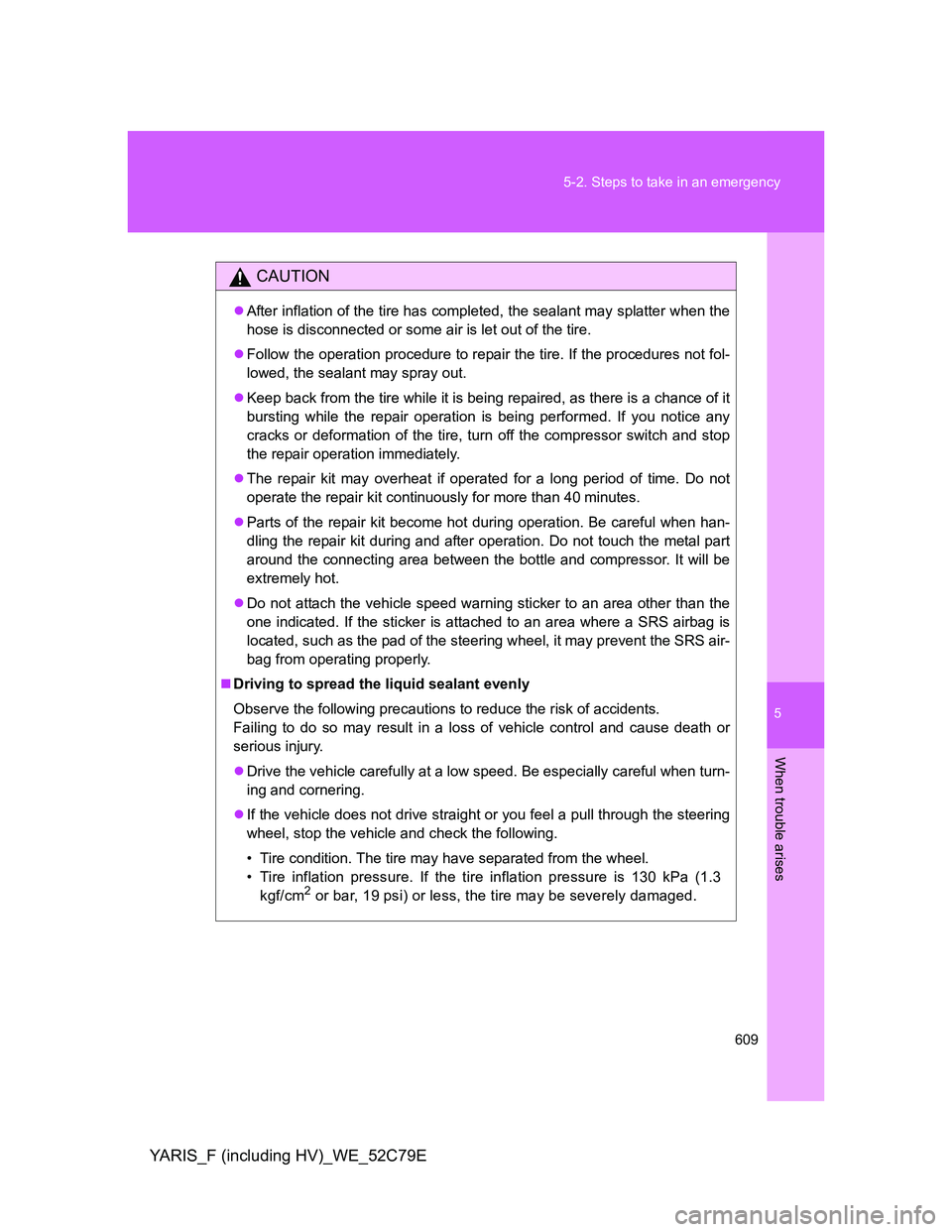
5
609 5-2. Steps to take in an emergency
When trouble arises
YARIS_F (including HV)_WE_52C79E
CAUTION
After inflation of the tire has completed, the sealant may splatter when the
hose is disconnected or some air is let out of the tire.
Follow the operation procedure to repair the tire. If the procedures not fol-
lowed, the sealant may spray out.
Keep back from the tire while it is being repaired, as there is a chance of it
bursting while the repair operation is being performed. If you notice any
cracks or deformation of the tire, turn off the compressor switch and stop
the repair operation immediately.
The repair kit may overheat if operated for a long period of time. Do not
operate the repair kit continuously for more than 40 minutes.
Parts of the repair kit become hot during operation. Be careful when han-
dling the repair kit during and after operation. Do not touch the metal part
around the connecting area between the bottle and compressor. It will be
extremely hot.
Do not attach the vehicle speed warning sticker to an area other than the
one indicated. If the sticker is attached to an area where a SRS airbag is
located, such as the pad of the steering wheel, it may prevent the SRS air-
bag from operating properly.
Driving to spread the liquid sealant evenly
Observe the following precautions to reduce the risk of accidents.
Failing to do so may result in a loss of vehicle control and cause death or
serious injury.
Drive the vehicle carefully at a low speed. Be especially careful when turn-
ing and cornering.
If the vehicle does not drive straight or you feel a pull through the steering
wheel, stop the vehicle and check the following.
• Tire condition. The tire may have separated from the wheel.
• Tire inflation pressure. If the tire inflation pressure is 130 kPa (1.3
kgf/cm
2 or bar, 19 psi) or less, the tire may be severely damaged.
Page 633 of 704
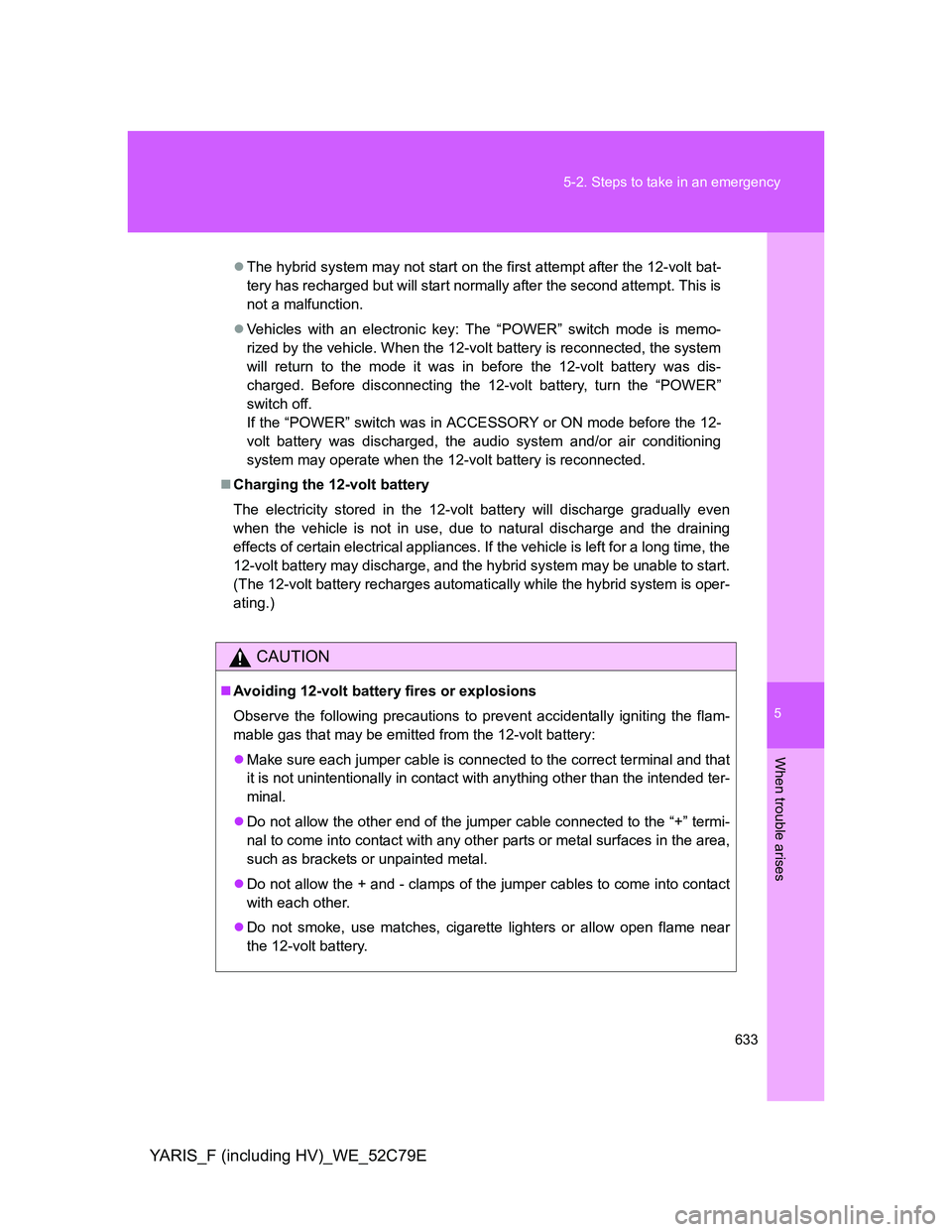
5
633 5-2. Steps to take in an emergency
When trouble arises
YARIS_F (including HV)_WE_52C79E
The hybrid system may not start on the first attempt after the 12-volt bat-
tery has recharged but will start normally after the second attempt. This is
not a malfunction.
Vehicles with an electronic key: The “POWER” switch mode is memo-
rized by the vehicle. When the 12-volt battery is reconnected, the system
will return to the mode it was in before the 12-volt battery was dis-
charged. Before disconnecting the 12-volt battery, turn the “POWER”
switch off.
If the “POWER” switch was in ACCESSORY or ON mode before the 12-
volt battery was discharged, the audio system and/or air conditioning
system may operate when the 12-volt battery is reconnected.
Charging the 12-volt battery
The electricity stored in the 12-volt battery will discharge gradually even
when the vehicle is not in use, due to natural discharge and the draining
effects of certain electrical appliances. If the vehicle is left for a long time, the
12-volt battery may discharge, and the hybrid system may be unable to start.
(The 12-volt battery recharges automatically while the hybrid system is oper-
ating.)
CAUTION
Avoiding 12-volt battery fires or explosions
Observe the following precautions to prevent accidentally igniting the flam-
mable gas that may be emitted from the 12-volt battery:
Make sure each jumper cable is connected to the correct terminal and that
it is not unintentionally in contact with anything other than the intended ter-
minal.
Do not allow the other end of the jumper cable connected to the “+” termi-
nal to come into contact with any other parts or metal surfaces in the area,
such as brackets or unpainted metal.
Do not allow the + and - clamps of the jumper cables to come into contact
with each other.
Do not smoke, use matches, cigarette lighters or allow open flame near
the 12-volt battery.
Page 639 of 704
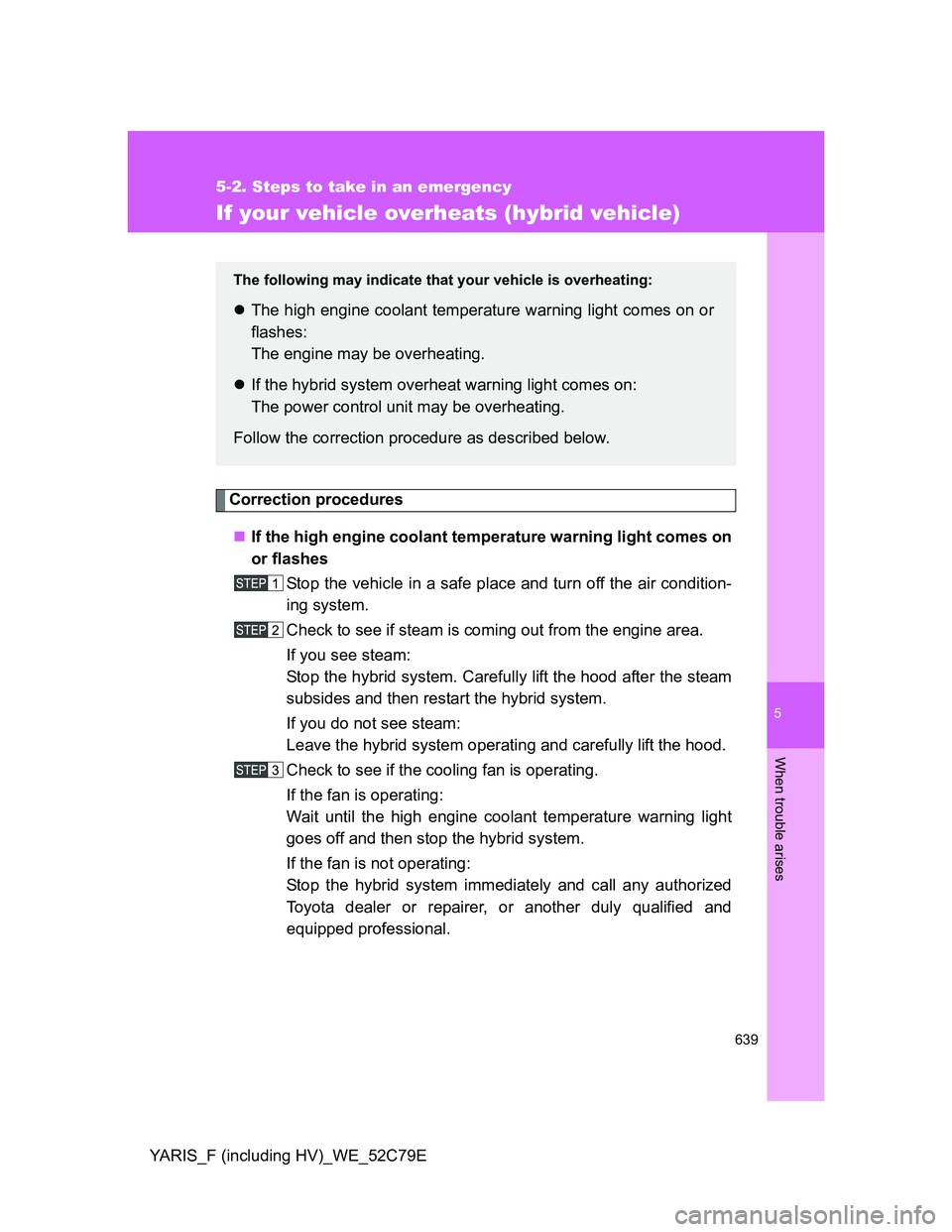
5
639
5-2. Steps to take in an emergency
When trouble arises
YARIS_F (including HV)_WE_52C79E
If your vehicle overheats (hybrid vehicle)
Correction procedures
If the high engine coolant temperature warning light comes on
or flashes
Stop the vehicle in a safe place and turn off the air condition-
ing system.
Check to see if steam is coming out from the engine area.
If you see steam:
Stop the hybrid system. Carefully lift the hood after the steam
subsides and then restart the hybrid system.
If you do not see steam:
Leave the hybrid system operating and carefully lift the hood.
Check to see if the cooling fan is operating.
If the fan is operating:
Wait until the high engine coolant temperature warning light
goes off and then stop the hybrid system.
If the fan is not operating:
Stop the hybrid system immediately and call any authorized
Toyota dealer or repairer, or another duly qualified and
equipped professional.
The following may indicate that your vehicle is overheating:
The high engine coolant temperature warning light comes on or
flashes:
The engine may be overheating.
If the hybrid system overheat warning light comes on:
The power control unit may be overheating.
Follow the correction procedure as described below.
Page 640 of 704
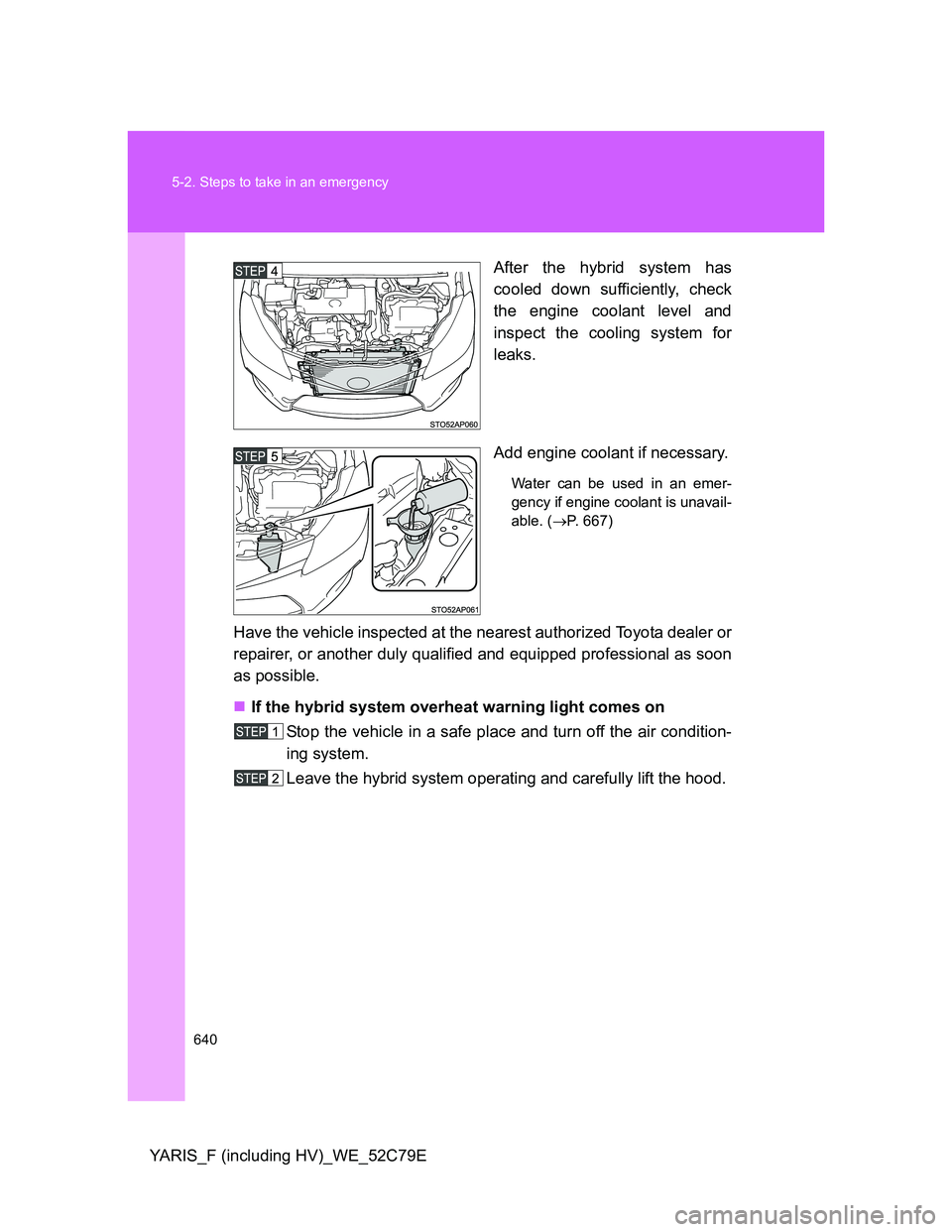
640 5-2. Steps to take in an emergency
YARIS_F (including HV)_WE_52C79EAfter the hybrid system has
cooled down sufficiently, check
the engine coolant level and
inspect the cooling system for
leaks.
Add engine coolant if necessary.
Water can be used in an emer-
gency if engine coolant is unavail-
able. (P. 667)
Have the vehicle inspected at the nearest authorized Toyota dealer or
repairer, or another duly qualified and equipped professional as soon
as possible.
If the hybrid system overheat warning light comes on
Stop the vehicle in a safe place and turn off the air condition-
ing system.
Leave the hybrid system operating and carefully lift the hood.